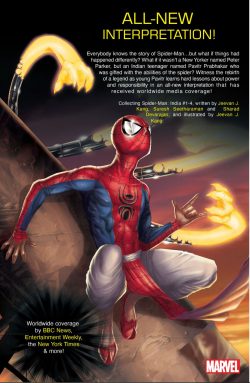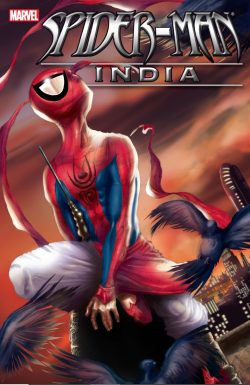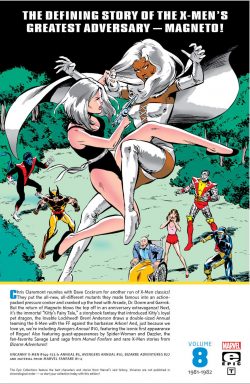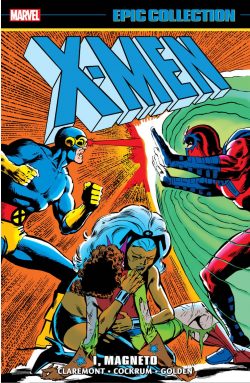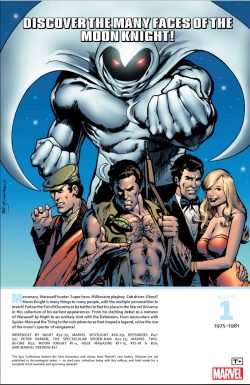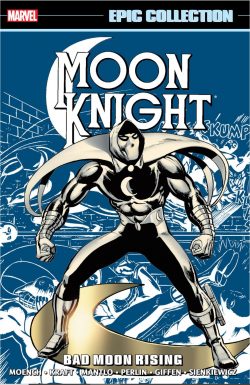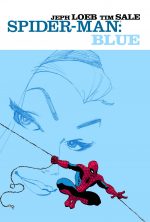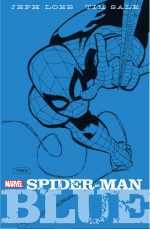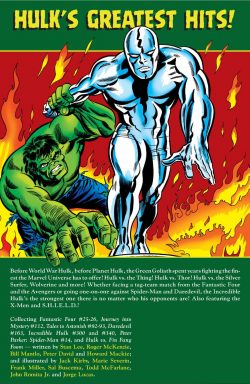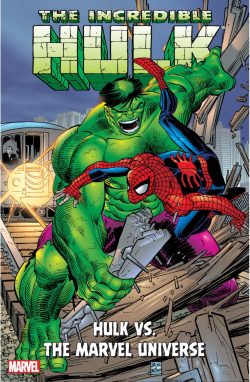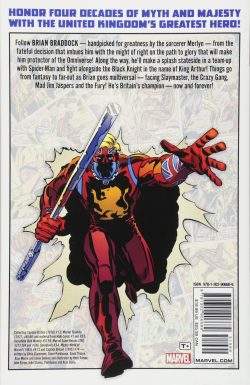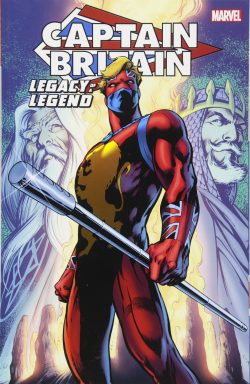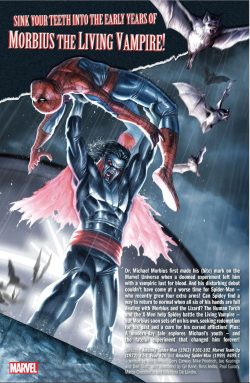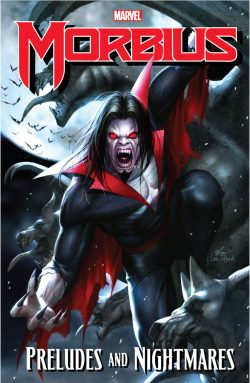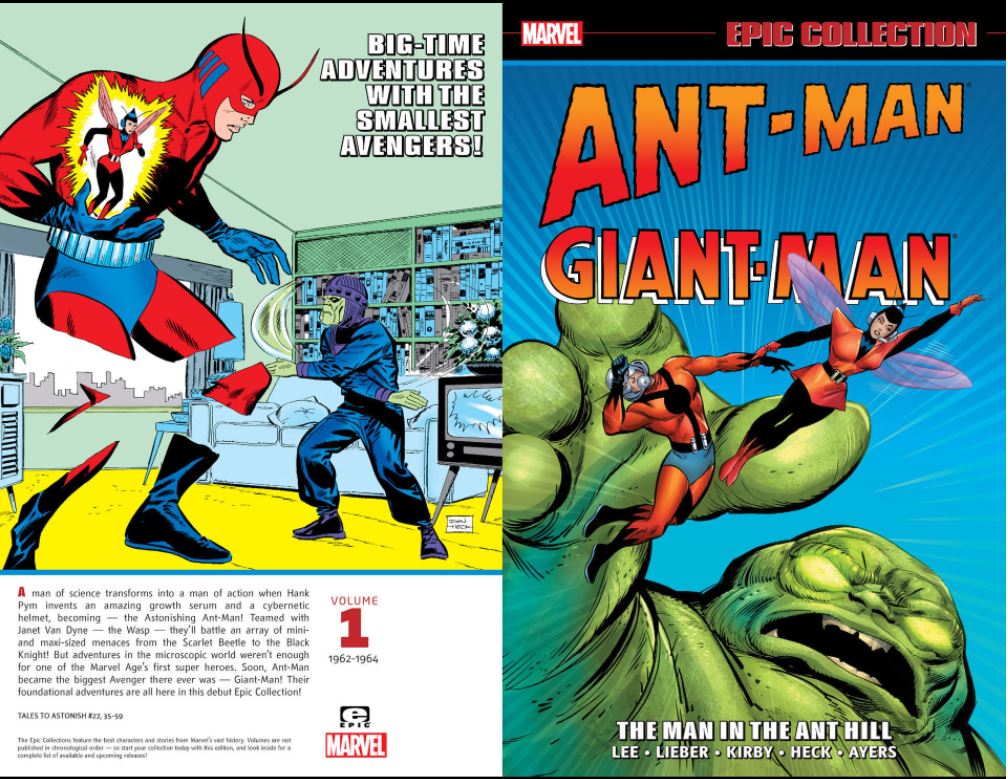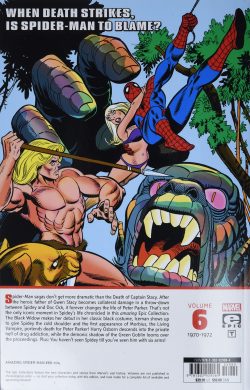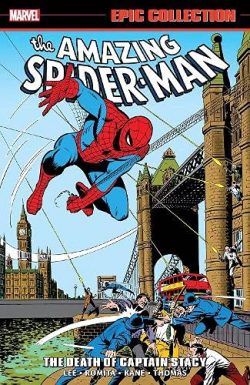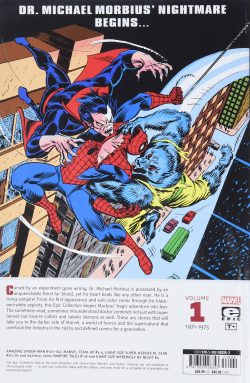
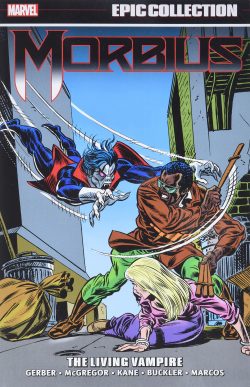
By Roy Thomas, Steve Gerber, Don McGregor, Gerry Conway, Mike Friedrich, Doug Moench, Gil Kane, Pablo Marcos, Ross Andru, Paul Gulacy, P. Craig Russell, Tom Sutton, Rich Buckler, Luiz Dominguez, Virgil Redondo, Mike Vosburg, Frank Robbins & various (DC Comics)
ISBN: 978-1-3029-2835-3 (TPB/Digital edition)
One of the most crucial aspects defining classical horror archetypes and characters is tragedy in equal amount to fear and violence. Frankenstein’s monster and werewolves are more victims than villains and even true predators like Dracula wed desire to necessity to underpin their dark depredations. This factor was the prime driver of Marvel’s many misunderstood monster stars in the early 1970s, and none more so than doomed researcher Michael Morbius who surrendered his humanity in service of physical survival and paid the price in shame, regret and guilt every time his thirst resurged….
This century’s transition of Marvel’s print canon to every size of screen seems unstoppable and with their pioneering horror hero/villain now a film presence, the company released a wave of collections to support the release. The most comprehensive and contextually crucial are the Epic Collections revisiting his life in more or less chronological order.
This initial titanic tome re-presenting Amazing Spider-Man #101-102; Marvel Team-Up #3-4; Giant-Size Super-Heroes #1; (Adventure into) Fear #20-26; Giant-Size Werewolf by Night #4, and pertinent material from Vampire Tales #1-8, cumulatively comprising cover-dates October 1971 to April 1975. It traces the science-spawned nosferatu through debut, guest villain shots and ultimately to his time in the spotlight as a confirmed horror hero…
It all begins with The Amazing Spider-Man #101: the second chapter in an anniversary trilogy tale begun by Stan Lee, Gil Kane & Frank Giacoia which saw the wallcrawler accidentally mutate himself and gain four extra arms…
Roy Thomas takes over with ‘A Monster Called… Morbius!’ as our 8-limbed arachnid oddity desperately seeks a way to reverse his condition. Whilst hiding out in Dr. Curt Connors’ Long Island home/lab, Peter Parker stumbles across a costumed horror who drinks human blood. The newcomer has just reached shore fleeing from a ship that he left a charnel house. Making matters even worse is Connors’ sudden arrival in scaly savage form of The Lizard. Suddenly surprised and always enraged, the saurian attacks, set on killing all intruders…
Amongst the many things banned by the Comics Code Authority in 1954 were horror staples zombies, werewolves and vampires, but changing tastes and spiralling costs of the era were seeing superhero titles dropping like flies in a blizzard.
With interest in suspense and the supernatural growing globally , all publishers pushed for a return to scary comics, and the covert introduction of a “Living Vampire” in superhero staple Spider-Man led to another challenge to the CCA, the eventually revision of the Code’s horror section and a resurgent rise of supernatural heroes and titles.
For one month Marvel also experimented with double-sized comic books (DC’s switch to 52-page issues lasted almost a year: August 1971 to June 1972 cover-dates). Thus, Amazing Spider-Man #102 featured a bombastic 3-chapter blockbuster brawl beginning with ‘Vampire at Large!’ wherein the octo-webspinner and anthropoid reptile joined forces to hunt a science-spawned bloodsucker after discovering a factor in the bitey brute’s saliva could cure both part-time monsters’ respective conditions.
‘The Way it Began’ abruptly diverges from the main narrative to present the tragic tale of Nobel Prize winning biologist Michael Morbius and how be turned himself into a haunted night-horror in hopes of curing his fatal blood disease, before ‘The Curse and the Cure!’ brought a blistering conclusion: restoring the status quo and requisite appendage-count…
Gerry Conway assumed the writer’s role for the third appearance of the living (not dead; never ever undead but “Living”, okay?), breathing humanoid predator who drank blood to live, in Marvel Team-Up #3 (July 1972). Illustrated by Ross Andru & Giacoia) it saw Spidey and Human Torch Johnny Storm hunting a resurgent Morbius after he attacks student Jefferson Bolt and somehow passes on his plague of thirst.
The conflicted scientist still seeks a cure and tracks old colleague Hans Jorgenson to Parker’s college, but his now-vampiric servant Bolt wants just what all true bloodsuckers want in ‘The Power to Purge!’…
The horror was still acting the villain in MTU #4, as the Torch was replaced by most of Marvel’s sole mutant team (The Beast having gone all hairy – and solo – in another science-based workaround to publish comic book monsters who were anything but supernatural) in ‘And Then… the X-Men!’
This enthralling thriller was magnificently illustrated by Kane at the top of his game and inked by Steve Mitchell, with the webslinger and X-Men at odds while both hunting the missing Jorgenson. After the unavoidable butting of heads, the heroes united to overcome Morbius and left him for Professor Charles Xavier to contain or cure…
Sadly, as we already know, his Nobel Prize-winning research only led to the death of his greatest friend and colleague, the abandonment of his true love and an unlife sentence as a rampaging killer…
Like Hawkeye, The Punisher, Wolverine and many others, Morbius followed the classic Marvel character arc and tradition of villain-turned-hero, but he fits far more in the mould of Doctor Doom, Magneto, The Hulk and Namor the Sub-Mariner: a driven protagonist whose needs and agendas generally set him apart from and in conflict with society and civilisation. Despite his every wish and effort, Morbius is repeatedly forced to feed on humanity: a victim of his own mutated body.
As the superhero decline continued and horror bloomed, Morbius found refuge in Marvel’s black-&-white magazines. Designated mature material, these titles skated around Comics Code rules, offering adult scenes and themes and an early home for numerous horror stars, barbarians like Conan and Kull, as well as more sophisticated superhero fare for The Punisher, Mockingbird, Moon Knight and others.
Vampire Tales #1 launched in August 1973 with ‘Morbius’ as lead feature. Following the painted cover by Esteban Maroto, contents page and vintage vamp movie still, a moody monochrome shocker by Steve Gerber & Pablo Marcos details the bloodsucker’s relocation to Los Angeles and immersion in its wild night life scene as he searches for former lover Martine… Instead he became entangled with sinister swinger Carolyn: a satanic cultist looking for recruits …and victims…
Lured to a séance with spiritualist Madame Laera, Morbius is intended to feed a demon but instead turns the tables on his attackers…
The bloody predator was a constant presence there, but in this instance story-sense overrules chronology and that first outing is followed by a return to four-colour publishing with a classic monster team-up from Giant-Size Super-Heroes #1 (June 1974).
With the monster boom in full swing, Marvel during this period flooded newsstands with horror antiheroes. Morbius had already launched in his own newsstand, code-sanctioned series but is here cannily paired with another of the Amazing Spider-Mans’s eeriest enemies in a double-length epic as ‘Man-Wolf at Midnight!’ (Conway, Kane & Mike Esposito) finds John Jameson again gripped by murderous moon-madness. Now, however, the tormented former astronaut was controlled by the Living Vampire and used to help the bloodsucker secure a possible cure for his appalling condition ‘When Strikes the Vampire!’
The saga then shifts to (Adventure into) Fear #20 (cover-dated February 1973). The title had previously hosted the macabre Man-Thing, and his/its promotion to a solo title gave Morbius opportunity to spread his own (glider) wings. Spawned by scripter Mike Friedrich and artists Paul Gulacy, Jack Abel & George Roussos, ‘Morbius the Living Vampire!’ revealed how the bloodsucker escaped X-Men captivity before moving to Los Angeles to live (whenever possible) off victims who deserved his voracious bite.
The initial tale also set up a bizarre relationship with Rabbi Krause and Reverend Daemond who sought to cure him, before one was exposed as a human devil, catapulting Morbius into intergalactic conflict that had shaped humanity over millennia.
That began in Fear #21 as ‘Project: Second Genesis!’ – by Gerber, Kane & Vince Colletta – sees Morbius ordered to consume a most remarkable little girl by Daemond. Despite his best intentions and all his moral compunctions, the vampire succumbs to temptation and attacks the child Tara only to face her super-powered future-self.
He is then reluctantly recruited by a cult of alien technologists who claim to have shepherded homo sapiens from barbarism to civilisation. These “Caretakers” are trying to create a race of supermen but are losing a secret war with Daemon.
By the time Morbius returns to the reverend’s fold however, the mage and his acolyte – Martine – have summoned cat demon Balkatar to destroy the Living Vampire…
Illustrated by Rich Buckler & Luis Dominguez ‘…This Vampire Must Die!’ finds Morbius easily overwhelmed before the victorious demon abruptly defies Daemond, bringing his foe to another realm – The Land Within – to become a very grim saviour. His kind breed but do not die and their king wants Morbius to cull the overcrowded herd by acting as an invited apex predator…
A little fan side note: this storyline fed into Gerber’s later arcs in The Defenders and Guardians of the Galaxy so continuity completists should pay close attention…
Instead the appalled vampire escapes and discovers he is on another planet, standing ‘Alone Against Arcturus!’ (Fear #23, by Gerber, P. Craig Russell & Colletta). The world has been devastated by genetic conflagration and is now populated by automatons, cyborgs and mutants who were once the same race as the Caretakers. They long only for death…
Realising the same unresolved conflict is currently unfolding on Earth, Morbius employs alien technology and volunteer “meals” to ‘Return to Terror!’ and his birthworld in #24 (October 1974, and inked by Jack Abel). Tragically the ship crash lands in front of Blade the Vampire Slayer…
Morbius has still not met an actual vampire and thinks he’s fighting a crazy man whilst Blade believes he’s facing a blood sucker from space and the brutal clash ends inconclusively. In the aftermath Morbius treks back to LA to find the war between Daemond and the Caretakers has intensified…
We now travel back to October 1973 for a run of Vampire Tales appearances starting with #2 and ‘The Blood Sacrifice of Amanda Saint!’ with Don McGregor, Buckler & Marcos revealing how a potential snack becomes an unlikely and enduring ally after devil cult Demon-Fire targets her.
Forced into the role of rescuer and defender, Morbius endures mystery, monsters, the torture of a toxic family and his own taste of American Gothic as he unceasingly defends Amanda whilst tearing apart a mystic secret society entwined around a culture in decline and modern American mythology.
The fightback begins with ‘Demon Fire!’ (#3 February 1974 and inked by Klaus Janson), moves mercilessly on to Malevolence, Maine and the ‘Lighthouse of the Possessed’ (April 1974, illustrated by Tom Sutton) to repel more monstrosities and turn back a ‘Blood Tide!’ (#5 June, Buckler & Ernie Chua/Chan)…
Morbius took a break in #6 – represented here by the cover and ‘Frontispiece’ – before we resume in Malevolence, Maine with #7, asking ‘Where is Gallows Bend and What the Hell Am I Doing There?’ before events shamble to a chilling conclusion in #8 (December 1974, limned by Mike Vosburg & Frank Chiaramonte) at ‘High Midnight’ presenting a final clash with hidden manipulators Apocalypse and Death-Flame and a return to less complex exploits in the colour comics…
The monochrome madness was supported throughout by painted covers from JAD, Boris, & Maroto and was all augmented by essays, photo-features and material from the magazines.
Also cover-dated December 1974, Fear #25 sported a Gerber plot and Doug Moench script for Frank Robbins & Frank Giacoia to illustrate. After briskly recapitulating the Caretakers of Arcturus storyline ‘And What of a Vampire’s Blood?’ rapidly brings events to a conclusion as Morbius’ presence triggers a premature final battle between the ancient schemers, Daemond, Martine, Tara, and the freshly-hatched Children of the Comet, resulting in ‘A Stillborn Genesis!’ (Moench, Robbins & Giacoia in #26, February 1975) and an abrupt change of direction…
That’s for the next volume however, whilst here we enjoy a crossover clash from April 1975’s Giant-Size Werewolf by Night #4 which brings the story portion of this pulse-pounding package to a close with a long-delayed and anticipated clash with fellow hostage to macabre fortune Jack Russell.
Cursed with uncontrolled lycanthropy under a full moon, and also a California kid, he endured ‘A Meeting of Blood’ (by Moench & Virgil Redondo) after the mutated biologist tracks Martine following Daemond’s destruction and discovers a possible cure for his own exsanguinary condition.
Unfortunately, the chase brings him into savage and inconclusive combat with a certain hairy hellion and the solution is forever lost…
This initial outing comes with a wealth of extras beginning with 9 house ads from 1973-1974; editorial page ‘Mail it to Morbius’ from Fear #21; un-inked original art pages by Kane; full art originals by Gulacy & Abel, Russell, Colletta & Abel; cover art by Kane, Giacoia, John Romita Sr., and Ron Wilson.
The compendium concludes with cover reproductions of Marvel Treasury Edition #14 (1977: front by Kane & Giacoia, back by Romita Sr., plus contents page by Dave Cockrum); #18 (1978: front & back by Bob Budiansky & Chan); cover galleries of Marvel Tales – #234 (Todd McFarlane), #252 (Marshal Rogers) and 253 (Moebius & Sylvain) – Spider-Man Megazine #3-4 (Ron Frenz/Stuart Immonen), Spider-Man Strange Adventures (Steve Lightle) and Marvel Selects: Spider-Man #2-3 4 (Mike Wieringo).
Compelling, complex, dark, often daft and always fretfully poised on the tightrope between superhero shenanigans and antihero angst, Morbius is one of Marvel’s most fluid and versatile characters, and can honestly promise something to please every type of fan or casual reader. Moreover, there’s even better to come that won’t work unless you take a big bite out of this tempting tome.
© 2021 MARVEL.

